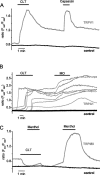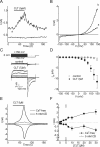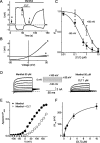Transient receptor potential channels in sensory neurons are targets of the antimycotic agent clotrimazole
- PMID: 18199759
- PMCID: PMC6670352
- DOI: 10.1523/JNEUROSCI.4772-07.2008
Transient receptor potential channels in sensory neurons are targets of the antimycotic agent clotrimazole
Abstract
Clotrimazole (CLT) is a widely used drug for the topical treatment of yeast infections of skin, vagina, and mouth. Common side effects of topical CLT application include irritation and burning pain of the skin and mucous membranes. Here, we provide evidence that transient receptor potential (TRP) channels in primary sensory neurons underlie these unwanted effects of CLT. We found that clinically relevant CLT concentrations activate heterologously expressed TRPV1 and TRPA1, two TRP channels that act as receptors of irritant chemical and/or thermal stimuli in nociceptive neurons. In line herewith, CLT stimulated a subset of capsaicin-sensitive and mustard oil-sensitive trigeminal neurons, and evoked nocifensive behavior and thermal hypersensitivity with intraplantar injection in mice. Notably, CLT-induced pain behavior was suppressed by the TRPV1-antagonist BCTC [(N-(-4-tertiarybutylphenyl)-4-(3-cholorpyridin-2-yl)tetrahydropyrazine-1(2H)-carboxamide)] and absent in TRPV1-deficient mice. In addition, CLT inhibited the cold and menthol receptor TRPM8, and blocked menthol-induced responses in capsaicin- and mustard oil-insensitive trigeminal neurons. The concentration for 50% inhibition (IC50) of inward TRPM8 current was approximately 200 nM, making CLT the most potent known TRPM8 antagonist and a useful tool to discriminate between TRPM8- and TRPA1-mediated responses. Together, our results identify TRP channels in sensory neurons as molecular targets of CLT, and offer means to develop novel CLT preparations with fewer unwanted sensory side effects.
Figures







References
-
- Alvarez J, Montero M, Garcia-Sancho J. High affinity inhibition of Ca2+-dependent K+ channels by cytochrome P-450 inhibitors. J Biol Chem. 1992;267:11789–11793. - PubMed
-
- Bautista DM, Jordt SE, Nikai T, Tsuruda PR, Read AJ, Poblete J, Yamoah EN, Basbaum AI, Julius D. TRPA1 mediates the inflammatory actions of environmental irritants and proalgesic agents. Cell. 2006;124:1269–1282. - PubMed
-
- Bautista DM, Siemens J, Glazer JM, Tsuruda PR, Basbaum AI, Stucky CL, Jordt SE, Julius D. The menthol receptor TRPM8 is the principal detector of environmental cold. Nature. 2007;448:204–208. - PubMed
-
- Benzaquen LR, Brugnara C, Byers HR, Gatton-Celli S, Halperin JA. Clotrimazole inhibits cell proliferation in vitro and in vivo. Nat Med. 1995;1:534–540. - PubMed
Publication types
MeSH terms
Substances
LinkOut - more resources
Full Text Sources
Other Literature Sources
Molecular Biology Databases
